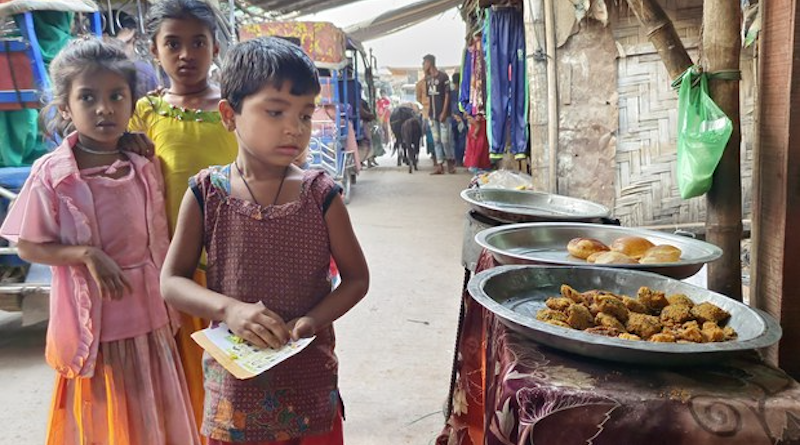Declining Funds And Food For Rohingya Refugees – OpEd
As if the living conditions in the refugee camps weren’t miserable enough for the Rohingya community, the world food assistance provider (WFP) recently announced that it would reduce the food rations for the refugee population by 17% beginning March 1, bringing the cost down from $12 to $10 per person (1,224 Bangladeshi Taka to 1,070 Bangladeshi Taka ) due to funding shortage of $125 million. This is expected to make the Rohingya’s already difficult situation even more difficult. UN special rapporteurs, Michael Fakhri, and Thomas Andrews have called this decision to be “unconscionable” to the Muslim Rohingya community especially when the month of Ramadan is just around the corner.
Since 2017, there have been almost one million refugees living in the 34 separate camps that are located in the area of Cox’s Bazar, Bangladesh. Of these refugees, more than half are women, girls, and children. Repatriation of the community to their homes in Rakhine has been repeatedly delayed by the state government of Myanmar as well as by its military, which has only served to lengthen their statelessness. The past five years spent in refugee camps have had a severe impact on the population, particularly on children. The World Food Programme reports that forty percent of Rohingya children are suffering from stunted growth, and twelve percent of them have acute malnutrition. Even currently 28 percent of newborn babies are underweight in Kutupalong hospital and Balukhali clinic where mothers are also suffering from acute malnutrition and anemia. Together with pregnant and breastfeeding mothers, these children will likewise be the worst victims of this ration cut. In addition to increasing domestic abuse, underage marriages, child labour, human and drug trafficking, and violence in the camps, this budget cut will also result in an increase in the number of people trying to leave the camps on boats, where many of them end up lost at sea.
Since 2015, more than 3,500 Rohingya have traveled by boat through the Andaman Sea to Malaysia, Indonesia, and other Southeast Asian nations, either to flee the unrest in Myanmar or because of the deteriorating conditions of the camps in Bangladesh. But regrettably, a lot of them never make it to shore. In fact, only last December, a boat carrying 180 Rohingya refugees disappeared in the sea, and it is assumed that they are all dead. Despite being aware of the dangers involved, refugees nevertheless continue on these trips because life in camps is inhumanely cruel. The $12 voucher won’t satisfy their hunger, and the host nation hasn’t given them any options for earning a living that would at least fill their stomachs. Their main source of income is the meager money they receive from local NGOs, which is insufficient for them to lead a decent life. Hence, they have to survive on basic foods like rice and lentils, and now that the voucher has been reduced, a healthy meal will become a dream to them.
In addition to all of this, funding for the Rohingya population has been gradually declining since 2020 as a result of the corona pandemic’s impacts on the economies of the donor countries. The Joint Response Plan (JRP) of 2019 by UN agencies and Bangladesh raised $636.7 million out of the $920.5 million required budget for the refugee programs. However, such funds saw a drastic reduction in the JRP of 2022 because less than half of the required budget of US$881 million was delivered by the donor. The ongoing Russia-Ukraine crisis, where $1.5 billion had been raised for humanitarian aid merely between initial calls for funds, is also a contributing factor in this reduction. The disparity in support for the victims in these nations demonstrates how the Rohingya crisis is losing global attention. Speaking about this, Tom Andrews, the UN Special Rapporteur on the situation of human rights in Myanmar, noted that the Rohingya are receiving rhetorical support from many UN members but “Rohingya families cannot eat political rhetoric.”
In the context of Bangladesh’s current economic crisis, it is also essential to comprehend the far-reaching consequences of these declining funds. The cost of living is increasing and purchasing power is decreasing due to the growing inflation in the country- a direct hit of the fuel crisis caused by the Russia-Ukraine war. It has already cost Bangladesh’s modest economy more than $100 million to construct fences around the refugee camps and prepare Bhasan Char (under Ashrayan Project-3) to move a portion of the refugee population. According to the Center for Policy Dialogue (CPD), a Bangladeshi think tank, this amount will continue to rise as Bangladesh may need to spend approximately $1.22 billion annually on Rohingya refugees, which is nearly impossible for the country given that it has recently taken out a $4.7 billion loan from IMF to resolve its balance of payment issue. If the Joint Response Plan 2023, which will request $876 million from donors for the Rohingya people, obtains the same level of waning enthusiasm, the vulnerable refugee population and the host nation will be exposed to an unprecedented disaster that no one is ready to face.
Sadia Aktar Korobi is a Student, Peace and Conflict Studies (MSS), Dhaka University, Bangladesh.

